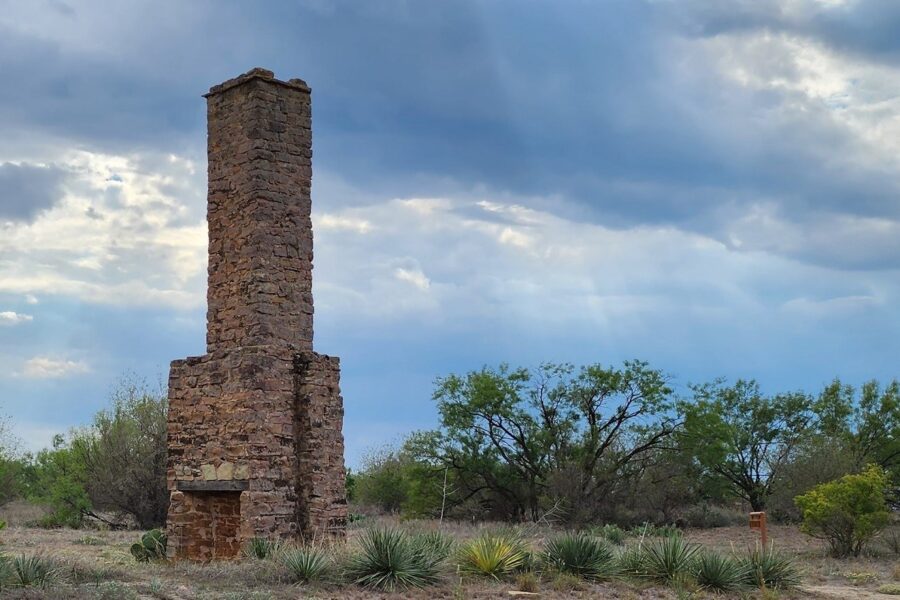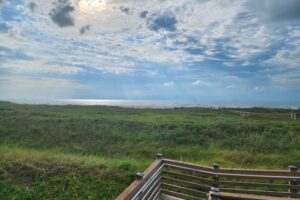Driving down the country road, I look out Michael’s side window. “Ooooh!” I exclaim, “I think those are the ruins of a ghost town I read about last night. Ghost towns are everywhere around here.”
Michael ignores me and continues his forward progress toward Abilene when we pass a sign. Fort Phantom Hill. Looking at me, he says, “Well?”
This fort is on our agenda for tomorrow, but we are here now. When Michael finds a place he deems safe to turn around, he makes a U-turn. Pulling into the parking lot of Fort Phantom Hill, it appears we are the only individuals intruding on the solitude of this lonely place. I’m not too surprised, this seems to be the story of our life.
I begin walking toward the chimney stacks in front of us. Michael walks the other way, and crosses the road. Turning, I follow. I’m not ready to lose him yet. Not here.


The Magazine
A dollhouse-sized stone structure stands before me—the MAGAZINE. I know what it is—a place to store ammunition, and apparently, it needs to be at a safe distance from the other buildings. There is a window in front and several high slits on each side. Michael explains it was a safety precaution in case the ammunition exploded.


The door must be on the opposite end, and automatically I begin to walk around the building. Then I glance at my sandal-shod feet. I look at the ground. It is full of dried mesquite beans, dried grasses, dirt, and small craters that I believe are home to a zillion tiny ants.
Michael shakes his head at my ignorance. “They’re doodlebug traps—they eat ants. Didn’t you ever play with doodlebugs when you were a kid?” He then explains the genius of the trap and how it works. This is obviously a case of girls—sugar and spice and everything nice—versus boys—snakes and snails and puppy dog tails.
Fort Phantom Hill’s Open Air Visitor Center

Back at the open air Visitor Center on the other side of the road, we begin reading information posted on the walls. Quickly scanning the paragraphs, Michael is already at the end of the story. He chuckles.
“What’s funny,” I ask.
“Someone said in 1892 the town that sprang up around the deserted post contained nothing but ‘one hotel, one saloon, one general store, one blacksmith shop, and 10,000 prairie dogs.'”
I continue reading from the beginning and get lost in a myriad of words and stories. After getting to the part about the prairie dogs, I realize Michael has disappeared. I leave the security of concrete and step onto the earthen path. There are two narrow trails leading from the small visitor pavilion to ward the ruins, and I’m at a loss as to which one Michael took. I look down, the path I chose is littered with a zillion giant red ants going about their business of survival. I step carefully. I look up and see a sign that tells me to BEWARE OF RATTLESNAKES.


Choosing left, I look ahead for snakes and down at my feet for red ants, almost forgetting to stop and admire the rock building ahead of me. Scanning further afield for sightings of Michael, I finally find him sitting on a low rock wall amidst a grove of chimneys and prickly pear cactus—patiently waiting.


There are no children’s squeals of laughter, no loud conversations. It is only me and Michael standing among the ruins with the whispers of old ghosts blowing through the twisted and knurled mesquite trees. We are alone in this wilderness. Michael takes my hand, and we walk forward together toward the beautiful desolation of long ago. This place, this moment, is perfection.



The Story of Fort Phantom Hill
The Journey
In November of 1851, five companies of the US Infantry were sent west to establish a post on the Clear Fork of the Brazos River. Some troops marched from as far away as the Arkansas border—almost 500 miles! Several days into their journey, a Texas Blue Norther struck. The wind howled through low scrub, and temperatures dropped below freezing within mere minutes. One of the quartermaster’s wagons got separated from the column of soldiers, resulting in a teamster, twenty-seven mules, and oxen freezing to death.
The Arrival
When the soldiers finally arrived at the point of land where they were tasked with building a fort to give safer passage for those Americans heading for the gold fields of California, one young lieutenant was so impressed with his surroundings that he wrote to his wife—
“We have arrived at a point known as Phantom Hill. Too much cannot be said for its beauty. The country around is alive with deer, turkey, and bear.”
Letter from Lt. Clinton W. Lear to his wife in Fort Washita
Barely a week later, he changed his tune—
“When I say to you that we have a beautiful valley to look upon, I have said everything favorable that could be said of this place. We are camped in a grove of blackjack two or three hundred yards of the creek, which is salt. Everybody is disgusted. Like the Dove after the Deluge, not one green sprig can we find to indicate this was ever intended by man to inhabit. Indeed, I cannot imagine that God ever intended for white man to occupy such a barren waste.”
Letter from Lt. Clinton W. Lear to his wife in Fort Washita
Construction
The soldiers had to build a fort, but there were no trees. The problem was solved by using oxen to haul timber from 40 miles away, but only enough to construct officer’s quarters and the hospital. A nearby quarry provided stone for the magazine, guardhouse, commissary, and chimneys. For all the other structures, they had to use something called jacal construction, a makeshift means of using vertical poles woven with brush and chinked with mud for walls. Thatch was used for roofs.




Many buildings used the jacal construction technique of vertical posts, which was typical frontier military expedient in Texas. These often drafty and critter-infested structures were a common source of complaint by Army wives, contributing to the “glittering misery” of antebellum garrison life on the fort.
Black & White Photo photographed by U.S. Army Signal Corps in1944 – located on Fort Clark near Bracketville, Texas
Fort Phantom Hill – Desertion
It didn’t take long for people to abandon ship—aka The Fort. The first one to go was the fort commander. He resigned his commission barely six months after arriving at Fort Phantom Hill—his excuse—he needed to return to England to claim title to a hereditary peerage. Not quite two years and three commanders later, during the spring of 1854, the fort was abandoned.
Shortly afterward, the jacal construction and the wooden buildings mysteriously burned to the ground. Speculation was that anyone from an irate officer’s wife to Indians to federal sympathizers started the fire. However, the last fort commander, who was there for two short weeks, was finally suspected of committing arson and was court-martialed and acquitted. Then the army decided to court martial him again. A career military man—he received a nine-month suspension.
Fort Phantom Hill Information
- Hours: Open daily from sun-up until sundown.
- Address: 10818 FM 600, Abilene, Texas 79604
- Phone: 325-677-1309
- E-mail: info@fortphantom.org
To see more stories on other Forts, click on the following link:
https://www.charlottestexashillcountry.com/category/texas-beyond-the-hills/texas-forts/









Leave a Reply
Your email is safe with us.